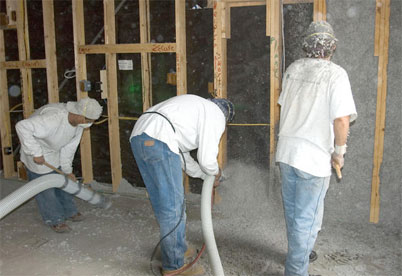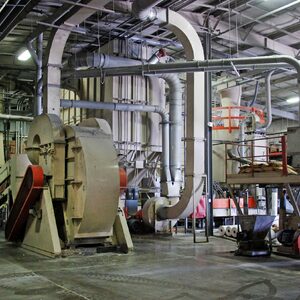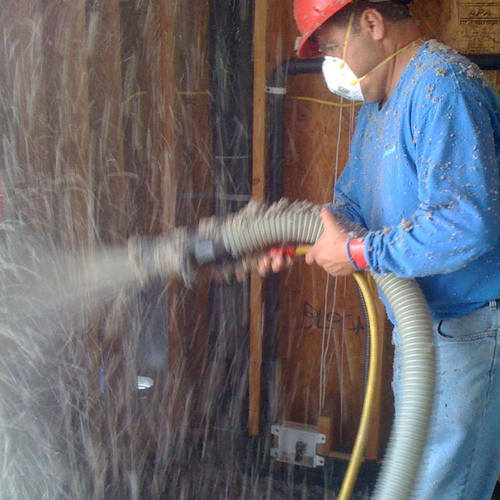
Image Credit: Advanced Insulation
Insulation is our number-one line of defense against high heating costs, and my favorite type of insulation is cellulose. Along with its effectiveness at slowing heat flow, cellulose insulation is a green product — made mostly out of an abundant waste product: old newspaper.
Most cellulose insulation is manufactured by first chopping recycled newspaper into small pieces, about an inch square. In an older process, this chopped newspaper is further shredded using a hammermill so that the smallest pieces are about a quarter-inch across. In most newer cellulose insulation plants, the chopped newspaper is fiberized—a process that disaggregates the individual fibers, producing a lower-density material—1.3 to 1.5 pounds per cubic foot. The lower the density, the more insulating value you get for a pound of insulation.
Once the newspaper is fiberized, flame retardant chemicals (15-20% by weight) are added to make the insulation less burnable. The most common flame retardants for cellulose are ammonium sulfate, borax, and boric acid, which are all considered safe for humans. The boron-based flame retardants have the added benefit of being toxic to insects and other pests that might be attracted to your home.
Most cellulose insulation is sold in 20- to 25-pound bags. It can be installed in several different ways. For loose-fill attic insulation, homeowners can rent equipment to fluff the material and blow it into the attic through a long flexible hose. Home centers selling cellulose insulation sometimes lend this equipment at no cost.
More commonly, cellulose is installed by trained insulation contractors using more sophisticated equipment. For attic installation, some professionals add a small amount of water and moisture-activated acrylic binder when they blow the cellulose into an attic so that the insulation doesn’t settle over time.
For walls, insulation contractors can install cellulose in three different ways. With damp-spray cellulose (sometimes still referred to as wet-spray, though the industry discourages this terminology), after the material is aerated, a small amount of water is mixed with it as it is blown into open wall cavities (before drywall is installed). Because of the moisture, the cellulose fibers stick together — like paper maché. After filling the wall cavities with damp-spray cellulose, the installer uses a special roller to shave the insulation even with the inside of the wall studs. With this installation technique, it’s important to let the insulation dry out for a few days — ideally longer — before the drywall is installed, and it’s best if the wall system is designed so that it can dry out if any moisture gets in.
Dense-packed cellulose is installed dry into a closed cavity through openings in the top of the wall cavity. By keeping the density at 3 or 3-1/2 pounds per cubic foot, the material won’t settle and leave sections of the wall with no insulation. This is often the best retrofit insulation option for uninsulated walls, because the wall finishes can be left in place — though some patching will usually be needed.
Finally, in an open wall cavity, some cellulose insulation contractors install plastic mesh between the wall studs and blow the insulation into the walls through the mesh. This way, moisture doesn’t have to be added and the walls can be closed in right away without worry about trapping moisture.
Because cellulose insulation can absorb and hold moisture, it’s especially important to keep walls dry. This is important no matter what the insulation material, but because cellulose is so effective at blocking airflow, wet cellulose won’t dry out as quickly as wet fiberglass.
Cellulose insulation provides R-3.2 to R-3.8 per inch, depending on how it’s installed. With the wall insulation options described, the R-value will be at the higher end of that range. Most fiberglass doesn’t insulate as well, because air can circulate through it more easily. This is also the reason that cellulose is actually better than fiberglass at stopping fires — as surprising as that sounds.
From an environmental standpoint, it is a big bonus that cellulose insulation is made mostly from recycled newspaper, one of the largest components of our solid waste stream. Cellulose insulation makes sense on many levels: it saves fuel, saves money, and provides an end use for recycling programs.
Weekly Newsletter
Get building science and energy efficiency advice, plus special offers, in your inbox.















6 Comments
Blown Cellulose
I've always heard that blown cellulose would settle over time leaving large gaps at the tops of each wall cavity. Have you found this to be true? Thanks.
Use the dense-packed method
Danny,
Settling will not be a problem if the cellulose contractor is experienced and skilled. Walls should be filled using the dense-packed method (aiming for a density of about 3.5 pounds per cubic foot).
cellulose additives will corrode wiring and copper pipes?
I was told by a cellulose manufacturer that the ammonium sulfate added to cellulose is highly corrosive to electrical wiring and junction boxes as well as copper water pipes if the cellusose is used in an area with high humidity or areas prone to moisture? I was told that ammonium sulfate supposedly will off-gas as well? Is this true or was he just trying to sell me a more expensive "all borate" product that does not use newprint?
Yes, ammonium sulfate can be corrosive
The advice you got is correct--that ammonium sulfate flame retardant is more corrosive than borate flame retardant. It may be, though, that this is only a concern above a certain humidity level and that for most applications it isn't too great a concern.
can cellulose be applied to a ceiling?
Can cellulose be applied to a ceiling and then enclosed behind a hard GWB ceiling where sprayfoam is applied directly to the underside of the subfloor?
Response to KH
KH,
Yes. It can be blown behind netting, drywall, or strapped polyiso.
Log in or create an account to post a comment.
Sign up Log in